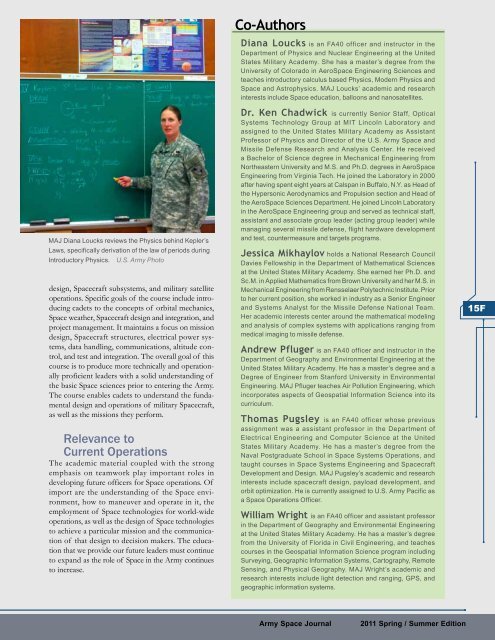Spring 2011 - Space and Missile Defense Command - U.S. Army
Spring 2011 - Space and Missile Defense Command - U.S. Army
Spring 2011 - Space and Missile Defense Command - U.S. Army
You also want an ePaper? Increase the reach of your titles
YUMPU automatically turns print PDFs into web optimized ePapers that Google loves.
MAJ Diana Loucks reviews the Physics behind Kepler’s<br />
Laws, specifically derivation of the law of periods during<br />
Introductory Physics. U.S. <strong>Army</strong> Photo<br />
design, <strong>Space</strong>craft subsystems, <strong>and</strong> military satellite<br />
operations. Specific goals of the course include introducing<br />
cadets to the concepts of orbital mechanics,<br />
<strong>Space</strong> weather, <strong>Space</strong>craft design <strong>and</strong> integration, <strong>and</strong><br />
project management. It maintains a focus on mission<br />
design, <strong>Space</strong>craft structures, electrical power systems,<br />
data h<strong>and</strong>ling, communications, altitude control,<br />
<strong>and</strong> test <strong>and</strong> integration. The overall goal of this<br />
course is to produce more technically <strong>and</strong> operationally<br />
proficient leaders with a solid underst<strong>and</strong>ing of<br />
the basic <strong>Space</strong> sciences prior to entering the <strong>Army</strong>.<br />
The course enables cadets to underst<strong>and</strong> the fundamental<br />
design <strong>and</strong> operations of military <strong>Space</strong>craft,<br />
as well as the missions they perform.<br />
Relevance to<br />
Current Operations<br />
The academic material coupled with the strong<br />
emphasis on teamwork play important roles in<br />
developing future officers for <strong>Space</strong> operations. Of<br />
import are the underst<strong>and</strong>ing of the <strong>Space</strong> environment,<br />
how to maneuver <strong>and</strong> operate in it, the<br />
employment of <strong>Space</strong> technologies for world-wide<br />
operations, as well as the design of <strong>Space</strong> technologies<br />
to achieve a particular mission <strong>and</strong> the communication<br />
of that design to decision makers. The education<br />
that we provide our future leaders must continue<br />
to exp<strong>and</strong> as the role of <strong>Space</strong> in the <strong>Army</strong> continues<br />
to increase.<br />
Co-Authors<br />
Diana Loucks is an FA40 officer <strong>and</strong> instructor in the<br />
Department of Physics <strong>and</strong> Nuclear Engineering at the United<br />
States Military Academy. She has a master’s degree from the<br />
University of Colorado in Aero<strong>Space</strong> Engineering Sciences <strong>and</strong><br />
teaches introductory calculus based Physics, Modern Physics <strong>and</strong><br />
<strong>Space</strong> <strong>and</strong> Astrophysics. MAJ Loucks’ academic <strong>and</strong> research<br />
interests include <strong>Space</strong> education, balloons <strong>and</strong> nanosatellites.<br />
Dr. Ken Chadwick is currently Senior Staff, Optical<br />
Systems Technology Group at MIT Lincoln Laboratory <strong>and</strong><br />
assigned to the United States Military Academy as Assistant<br />
Professor of Physics <strong>and</strong> Director of the U.S. <strong>Army</strong> <strong>Space</strong> <strong>and</strong><br />
<strong>Missile</strong> <strong>Defense</strong> Research <strong>and</strong> Analysis Center. He received<br />
a Bachelor of Science degree in Mechanical Engineering from<br />
Northeastern University <strong>and</strong> M.S. <strong>and</strong> Ph.D. degrees in Aero<strong>Space</strong><br />
Engineering from Virginia Tech. He joined the Laboratory in 2000<br />
after having spent eight years at Calspan in Buffalo, N.Y. as Head of<br />
the Hypersonic Aerodynamics <strong>and</strong> Propulsion section <strong>and</strong> Head of<br />
the Aero<strong>Space</strong> Sciences Department. He joined Lincoln Laboratory<br />
in the Aero<strong>Space</strong> Engineering group <strong>and</strong> served as technical staff,<br />
assistant <strong>and</strong> associate group leader (acting group leader) while<br />
managing several missile defense, flight hardware development<br />
<strong>and</strong> test, countermeasure <strong>and</strong> targets programs.<br />
Jessica Mikhaylov holds a National Research Council<br />
Davies Fellowship in the Department of Mathematical Sciences<br />
at the United States Military Academy. She earned her Ph.D. <strong>and</strong><br />
Sc.M. in Applied Mathematics from Brown University <strong>and</strong> her M.S. in<br />
Mechanical Engineering from Rensselaer Polytechnic Institute. Prior<br />
to her current position, she worked in industry as a Senior Engineer<br />
<strong>and</strong> Systems Analyst for the <strong>Missile</strong> <strong>Defense</strong> National Team.<br />
Her academic interests center around the mathematical modeling<br />
<strong>and</strong> analysis of complex systems with applications ranging from<br />
medical imaging to missile defense.<br />
Andrew Pfluger is an FA40 officer <strong>and</strong> instructor in the<br />
Department of Geography <strong>and</strong> Environmental Engineering at the<br />
United States Military Academy. He has a master’s degree <strong>and</strong> a<br />
Degree of Engineer from Stanford University in Environmental<br />
Engineering. MAJ Pfluger teaches Air Pollution Engineering, which<br />
incorporates aspects of Geospatial Information Science into its<br />
curriculum.<br />
Thomas Pugsley is an FA40 officer whose previous<br />
assignment was a assistant professor in the Department of<br />
Electrical Engineering <strong>and</strong> Computer Science at the United<br />
States Military Academy. He has a master’s degree from the<br />
Naval Postgraduate School in <strong>Space</strong> Systems Operations, <strong>and</strong><br />
taught courses in <strong>Space</strong> Systems Engineering <strong>and</strong> <strong>Space</strong>craft<br />
Development <strong>and</strong> Design. MAJ Pugsley’s academic <strong>and</strong> research<br />
interests include spacecraft design, payload development, <strong>and</strong><br />
orbit optimization. He is currently assigned to U.S. <strong>Army</strong> Pacific as<br />
a <strong>Space</strong> Operations Officer.<br />
William Wright is an FA40 officer <strong>and</strong> assistant professor<br />
in the Department of Geography <strong>and</strong> Environmental Engineering<br />
at the United States Military Academy. He has a master’s degree<br />
from the University of Florida in Civil Engineering, <strong>and</strong> teaches<br />
courses in the Geospatial Information Science program including<br />
Surveying, Geographic Information Systems, Cartography, Remote<br />
Sensing, <strong>and</strong> Physical Geography. MAJ Wright’s academic <strong>and</strong><br />
research interests include light detection <strong>and</strong> ranging, GPS, <strong>and</strong><br />
geographic information systems.<br />
15F<br />
<strong>Army</strong> <strong>Space</strong> Journal<br />
<strong>2011</strong> <strong>Spring</strong> / Summer Edition
















